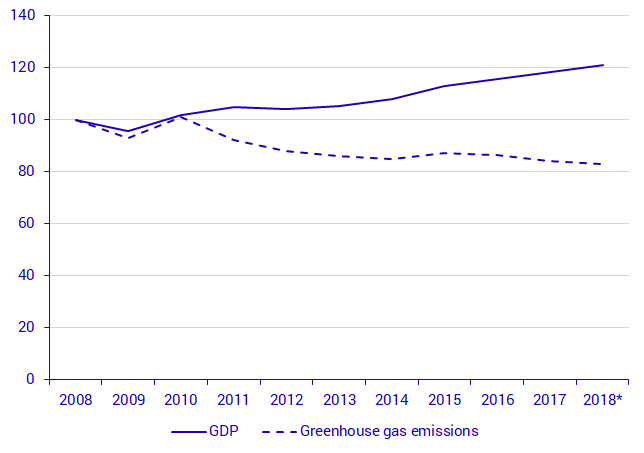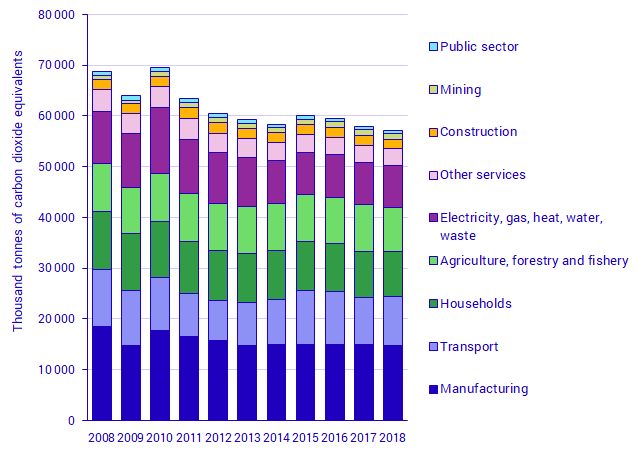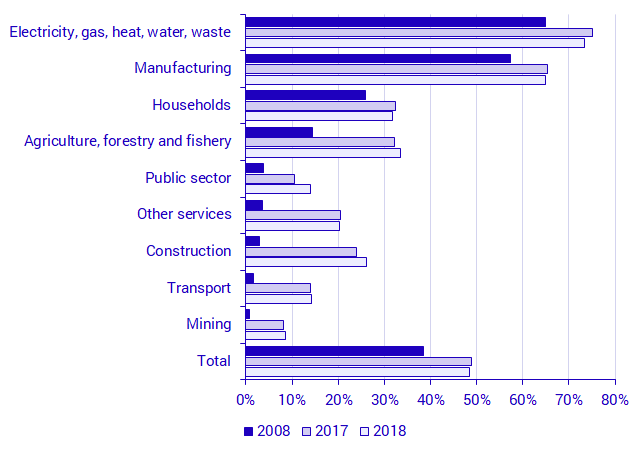Environmental accounts – Emissions to air 2018
Strong economic development and slowed decrease in greenhouse gas emissions in 2018
Statistical news from Statistics Sweden 2020-03-26 9.30
Statistics Sweden’s environmental accounts report emissions to air from the Swedish economy and households. Between 2008 and 2018, greenhouse gas emissions decreased by approximately 17 percent. Over the same period, GDP grew by 21 percent.
Greenhouse gas emissions followed the general economic trend between 2008 and 2010. Between 2010 and 2014, greenhouse gas emissions fell by 16 percent, while GDP grew by 6 percent. Since then, emissions have decreased by only 2 percent up to 2018, while GDP grew by 12 percent over the same period. In 2018, greenhouse gas emissions by the Swedish economy and households amounted to 57 million tonnes of carbon dioxide equivalent.

*2018 GDP figures in fixed prices are preliminary. Source: Statistics Sweden, Environmental accounts and National accounts.
Lower emissions in all industries except in the transport industry
Greenhouse gas emissions from agriculture, forestry and fishing, the manufacturing industry, as well as electricity, gas, district heating and water supply decreased in 2018 compared with 2017. Greenhouse gas emissions by the manufacturing industry, which accounts for almost a quarter of total emissions from the Swedish economy, decreased by 1 percent.
Emissions from the transport sector (i.e. haulage, shipping, and aviation) increased by 4 percent in 2018 compared with 2017. This is mainly due to an increase of 13 percent in emissions by shipping companies. Land transport emissions fell by 3 percent during the same period, while emissions from the aviation industry remained unchanged.

Source: Statistics Sweden, Environmental accounts.
Proportion of biofuels decreased
The proportion of biofuel consumption, that is, the consumption of biofuels in relation to total fuel consumption in the Swedish economy (fossil and biogenic fuels) has increased from 38 percent in 2008 to 48 percent in 2018. This is due to the fact that the amount of biofuels has increased, while the amount of fossil fuels has decreased over the period. However, between 2017 and 2018, the proportion of biofuels decreased by almost half a percent.
The proportion of biofuels is largest in electricity, gas and district heating plants and in the manufacturing industry. These industries also account for the largest use of biofuels overall. However, it is worth noting that the proportion of biofuels in these industries decreased between 2017 and 2018. The proportion of biofuels also decreased in households during the same period.

Source: Statistics Sweden, Environmental accounts
Environmental economic profile update in late 2020
Statistic Sweden’s Environmental Accounts also reports various industries’ emissions in relation to employment and value added (industry’s contribution to GDP). However, the statistics on annual air emissions are prepared before the annual statistics on the employment rate and value added. Therefore, emission intensities and environmental-economic profiles will be updated later this year when this data becomes available for reference year 2018.
Use the analytical tool for environmental economic data
Environmental accounts data is available via the online analysis tool that combines data from the Environmental Accounts with economic data. This tool can be used to explore emissions statistics from both production and consumption perspectives together with other environmental economic data. Using the tool, it is possible to generate tailored indicators, compare emissions to the environment from different industrial sectors, and study the relationship between demand in the economy, energy use and emissions.
Definitions and explanations
The Environmental Accounts present national environmental statistics and economic statistics in a common framework using NACE industry classification. This provides opportunities to analyse the relationship between the economy and the environment. Whereas emissions statistics with a territorial perspective include all emissions that arise within Sweden’s borders, the starting point for the environmental accounts is the environmental impact of Swedish economic actors, regardless of where in the world their emissions occur. This means that a “residency adjustment” is made for the environmental accounts perspective compared to the territorial perspective, where emissions caused by Swedish companies outside of Sweden’s borders and that contribute to Sweden’s GDP are added, while foreign actors’ emissions in Sweden are deducted. Emissions and absorption from land use, land use change and forestry (LULUCF) and carbon dioxide storage (CCS) are not reported in the environmental accounts.
These published statistics on emissions to air are based on a production perspective. Emissions are reported for the industry where the emissions occur, including households’ direct emissions (i.e. combustion of fossil fuels, heating, and other direct emissions). Indirect emissions from imports and other consumption of goods and services are not included.
Statistics on emissions to air published by the Swedish Environmental Protection Agency (EPA) follow the UNFCCC framework, covering emissions within Sweden’s territorial borders. Sectors are disaggregated by emissions category, not by industry. Emissions and removals from land use and land use change are included, while emissions from international aviation and navigation are reported separately.
Territoriella utsläpp och upptag av växthusgaser (Swedish)
Revisions
A number of revisions have been implemented since the previous publication.
For the reference year 2018, the register of reports to the Swedish Energy Agency in accordance with Sweden’s implementation of the EU’s Renewable Energy Directive (2009/28/EC) has been used as a source for activity data for the transport sector. Up to and including reference year 2017, data from Statistics Sweden’s monthly fuel, gas and inventory statistics are used. The reason for the change of input data is that the monthly fuel, gas and inventory statistics have been deemed to be associated with significant uncertainties from the start of reference year 2018. The uncertainties are considered to have arisen due to a revision of the data collection survey used for the monthly fuel, gas and inventory statistics that was implemented at the start of 2018.
Additionally, for the complete time series 2008-2018, a new method of residence adjustment has been implemented for this publication. This residence adjustment is applied to adjust statistical sources with a territorial perspective used to produce these statistics to the environmental accounts’ economic perspective. The new residency adjustment applies primarily to transport: heavy duty road transport (primarily within H49 land transport companies, but also other industries such as construction), maritime transport (H50) and aviation (H51). The new residency adjustment for heavy duty road vehicles is based on data on transport work (in tonne-km) for Swedish companies abroad and foreign companies in Sweden. These input data are produced by Transport Analysis (Trafikanalys). For maritime transport and aviation, the new residence adjustment is based on data for Swedish companies’ expenditure on fuel in Statistics Sweden’s National Accounts database on intermediate use in the economy, PRIOR.
More information on these updates is available on the System of Environmental and Economic Accounts web page under Documentation.
Next publishing will be
The next statistical news on quarterly emissions to air through the fourth quarter of 2019 will be published on 2020-05-14 at 09.30 am. Preliminary statistics for 2019 will be published at this time.
The next statistical news on annual emissions to air, 2008-2019 (final statistics) is scheduled for publication in spring 2021.
Statistical Database
More information is available in the Statistical Database
Feel free to use the facts from this statistical news but remember to state Source: Statistics Sweden.
